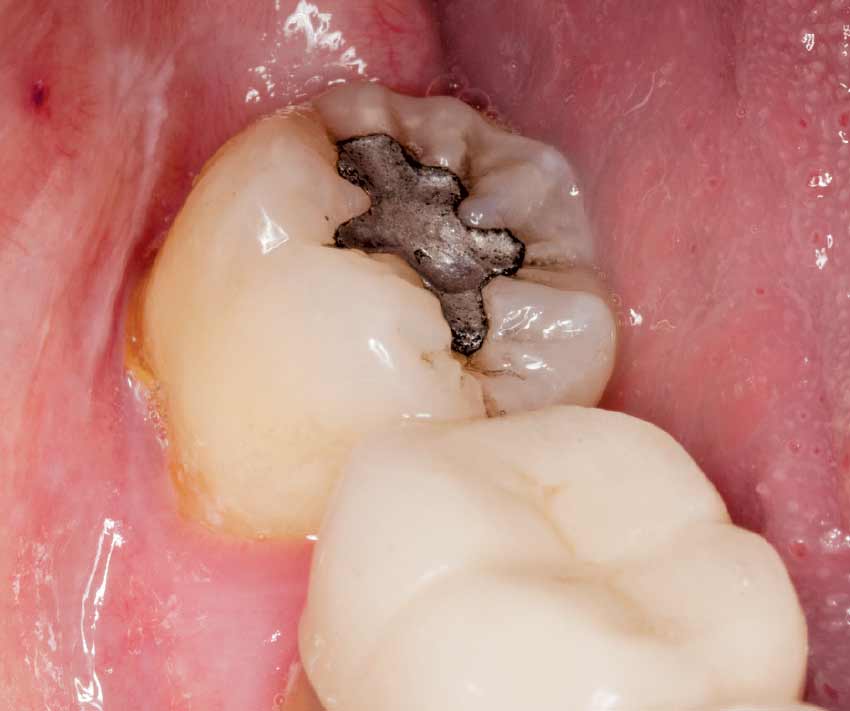Should I Get My Silver Fillings Removed?
Health organizations agree that amalgam fillings are safe
Dear Doctor,
I've heard that silver fillings actually contain mercury. Since mercury is toxic, should I have those fillings removed?
Dear Sharon,
Hundreds of millions of people (myself included) have had their cavities treated with "silver" fillings, a material dentists call amalgam. Dental amalgam has been used to restore teeth for more than 150 years, yet concerns about its safety arise from time to time. That's understandable, given that according to the U.S. Food and Drug Administration, about 50 percent of the starting material for dental amalgam is mercury. In dental amalgam, liquid mercury is mixed with a powder of silver, tin, copper and other metals, forming a putty that is molded to the prepared tooth. Mercury reacts with these powders to form solid inter-metallic compounds that are stable and biocompatible (suitable for use with living tissue).
 |
Since the toxic effects of mercury have long been recognized, you may wonder whether it's safe to use in the human mouth. But you can rest assured: Numerous studies have shown that dental amalgam is a safe and effective option for filling cavities. Dental amalgam is not the same as mercury.
Not All Mercury Is The Same
Mercury occurs naturally in Earth's crust and can enter the environment as an industrial by-product. We are exposed to mercury through air, water and food, but at low levels it is not known to cause any adverse effects. In addition, not all forms of mercury are equally dangerous to living tissues. Elemental mercury, a shiny liquid metal, is the kind used to make silver fillings. Yet after the amalgam sets, there is no elemental mercury in the filling and it is non-toxic. This is analogous to sodium metal being highly toxic — but when reacted with chlorine (also a toxin) it forms sodium chloride: common salt, which is essential for life.
The most dangerous form of the element is methylmercury, a compound that is formed when mercury — such as that released into the environment via bacterial processes — combines with organic molecules. This substance is more likely to be stored in body tissues, and may build up over time. It travels through the aquatic food chain and is present in high concentrations in certain large fish. That's why young children and women who may become pregnant are advised to limit their consumption of some types of fish. This potentially dangerous compound isn't present in dental amalgam.
Silver Fillings — Still Popular
Dental restorative materials (composite resins, for example) are now available that contain no mercury and match the color of your teeth — so you may wonder why dull, metallic-colored amalgam fillings are still used. In fact, for back teeth where color may not be an issue, dental amalgam is used by many dentists because it offers several advantages. Dental amalgam is the least expensive dental filling material, it is the easiest to work with, and it outlasts all other direct filling materials. Amalgam hardens quickly, so it is often used for areas below the gum line that are difficult to keep dry and for patients who have a hard time sitting still through dental procedures.
Most mercury exposure from amalgam occurs while a filling is being placed or removed. In the past, no mercury was thought to escape from fillings once they were in place. However, advances in measuring techniques reveal that amalgam fillings release trace amounts of mercury vapor. These miniscule amounts should not cause concern, since they add up to less mercury than we take in from breathing, eating, drinking or working in certain occupations. A 2008 study revealed that even in a mouth full of amalgam fillings, the amount of mercury released is far below the level associated with ill effects as established by the World Health Organization. We get 8-50 times more mercury from our diet, especially from fish but also from some vegetables, breads and beverages. While the European Parliament recently voted to phase out the use of mercury in dental fillings by 2030, the main reason for their decision was not related to health concerns; instead, it was intended to further reduce the risk of mercury contamination in the environment from dental waste disposal.
The Bottom Line
Over several decades, many research studies have looked into the health effects of amalgam fillings. None confirmed a link between dental amalgam and health problems.
On the plus side, dental amalgam is the most thoroughly tested material for dental restorations; much more is known about its safety than about the safety of newer filling materials. After a comprehensive review of the literature, the American Dental Association reaffirms that "the scientific evidence supports the position that amalgam is a valuable, viable and safe choice for dental patients." If this were not true, we would not be using amalgam. Other organizations which have deemed amalgam fillings safe include the U.S. Centers for Disease Control and Prevention, the American Academy of Pediatrics, the U.S. Food and Drug Administration, and the World Health Organization.
The bottom line? There is no medical reason for having silver fillings removed as a precautionary measure. On the other hand, removing amalgam fillings exposes you to more mercury than leaving them in. That's because the process of breaking up the amalgam releases mercury vapor and tiny particles that could be ingested. Plus, you will lose healthy tooth structure when you get a replacement filling. So if your silver fillings are intact, you have not experienced any adverse effects (such as an allergic reaction) and there is no decay under the filling, it may be better to leave your amalgam fillings just as they are.

